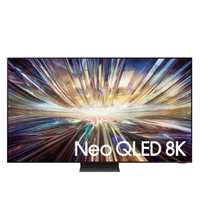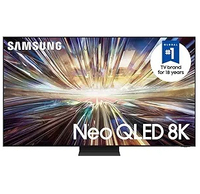The Sony Bravia 9 is a mini-LED TV that manages to outdo its high-end TV competition when it comes to overall brightness. Its excellent local dimming presents strong competition for OLED TVs, and an anti-reflective screen makes it a great option for sports. Sony’s switch from OLED to mini-LED for its flagship TV seems well justified by the Bravia 9, and it’s also priced lower than other OLED and mini-LED flagships.
Pros
- +
High brightness
- +
Refined local dimming
- +
Anti-reflective screen
Cons
- –
Pricey
- –
Only two HDMI 2.1 ports
- –
No HDR10+ support
Why you can trust TechRadar We spend hours testing every product or service we review, so you can be sure you’re buying the best. Find out more about how we test.
Sony Bravia 9: Two-minute review
The Sony Bravia 9 is the company’s flagship TV for 2024. TV tech followers were taken aback when the company announced earlier this year that a mini-LED model would be its new flagship, a position traditionally reserved for the best OLED TVs like the Sony A95L. However, in subsequent demonstrations, Sony showed off its new XR Backlight Master Drive with High Peak Luminance tech, exclusive to the Bravia 9, and it became clear why it made a jump to mini-LED.
Sony’s Bravia 9 is intended to follow in the footsteps of the company’s new BVM-HX3110 professional monitor, used when shows are being created, which bumps peak brightness up to 4,000 nits – that compares to the previous pro monitor’s 1,000 nits. The BVM-HX3110 gives creators an option to produce movies and TV shows with a wider dynamic range – something they expect to see happen as the new monitor gets deployed in studios. And while the Bravia 9 can’t hit the same brightness peaks as Sony’s pro monitor, it allows for programs developed with these super-bright highlights in mind to be accurately displayed using HDR tone mapping tech developed for the BVM-HX3110. That’s Sony’s claim, anyway.
That’s not to say the Bravia 9 isn’t sufficiently bright – it surpassed its high-end competition among the best TVs in our measurements and is significantly brighter than last year’s Sony X95L mini-LED model. Equally importantly, it has highly refined local dimming, delivering OLED-like black depth and powerful HDR highlights with almost none of the backlight blooming effects mini-LED TVs typically suffer from. This benefits movies most, though the Bravia 9 also has an effective anti-reflective screen coating and a wide viewing angle feature that, combined with its high brightness, make it one of the best TVs for sport.
The Bravia 9’s excellent audio features also rank it among the best TVs for sound, too. Its built-in 2.2.2-channel speaker system supports Dolby Atmos and DTS:X, and it uses tweeters built into the sides and top of the TV’s frame for accurate sound placement and spatial audio rendering. An Acoustic Center Sync feature also lets it be used as a center channel speaker with a compatible Sony soundbar or the company’s Bravia Theater Quad wireless speaker system.
Sony’s “One Slate” design for the Bravia 9 gives it a sleek yet substantial look and incorporates four-way support feet to accommodate a range of furniture and soundbar placement options. The TV also comes with Sony’s new Eco Remote, which forgoes batteries for USB-C charging.
The TV’s Google TV smart interface is a reliable option for streaming and offers a good level of customization plus integration with smart home protocols from Google, Amazon Alexa, and Apple HomeKit. It also supports hands-free voice commands and wireless streaming from devices via Apple AirPlay 2 and Chromecast built-in.
Gaming features are solid on the Bravia 9, with 4K 120Hz, VRR, and ALLM support as well as Sony’s Game Menu for making quick gaming-related adjustments. The TV is “Perfect for PlayStation 5,” with optimal picture settings for gaming automatically activated when a PS5 console is connected. The one key drawback for gaming is that the Bravia 9 only features two HDMI 2.1 ports compared to the four HDMI 2.1 ports found on other premium TVs.
While the $2,999 price of the 65-inch Sony Bravia 9 I tested may seem high, it’s less than what you’ll pay for other premium TVs in the same screen size. Given the level of performance and features on offer, it is a relative bargain on the high-end TV scene.
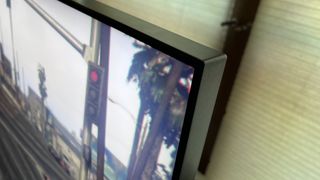
Sony Bravia 9 review: Price and release date
- Release date: May 2024
- 65-inch: $2,999
- 75-inch: $3,499 / £4,499 / AU$6,995
- 85-inch: $4,799 / £4,999/ AU$7,995
The Sony Bravia 9 series was released in May 2024 in the US in 65-, 75-, and 85-inch screen sizes. It is Sony’s flagship mini-LED TV for 2024 and is followed in the lineup by the Sony Bravia 7 series mini-LED models, which additionally feature a 55-inch screen size.
Bravia 9 series TVs are limited to a 75-inch and 85-inch screen size in the UK and Australia.
The price may seem steep, but it’s not out of line with other flagship mini-LED models – the Samsung QN90D 65-inch costs $2,699, for example. On the OLED side, the Samsung S95D costs $3,399.
Sony Bravia 9 review: Specs
Swipe to scroll horizontally
| Screen type: | QLED with mini-LED |
| Refresh rate: | 120Hz |
| HDR support: | Dolby Vision, HDR10, HLG |
| Audio support: | Dolby Atmos, DTS:X |
| Smart TV: | Google TV |
| HDMI ports: | 4 (2x HDMI 2.1) |
| Built-in tuner: | ATSC 3.0 (US) |
Sony Bravia 9 review: Benchmark results
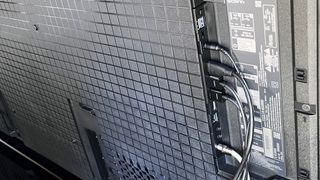
Sony Bravia 9 TV review: Features
- XR Backlight Master Drive with High Peak Luminance
- Wide viewing angle and anti-reflection screen
- Special features for PlayStation 5
As the flagship TV in Sony’s 2024 lineup, the Bravia 9 is unsurprisingly packed with premium features. XR Backlight Master Drive with High Peak Luminance is Sony’s name for the Bravia 9’s exclusive backlight tech, and it uses a highly miniaturized, 22-bit driver that allows for a greater number of mini-LED modules to be deployed in the backlight and increased local dimming zones along with it (325% more than last year’s flagship Sony X95L mini-LED TV, according to Sony). Along with this sheer boost in backlight horsepower, the Bravia 9 also features a new algorithm that allows for more refined local dimming in the backlight to eliminate light bleeding effects.
Sony’s top XR processor is used in the Bravia 9, and with it comes features such as XR Clear Image 4K upscaling for HD and lower-resolution content and XR Motion Clarity to reduce motion blur and judder. X-Wide Angle helps pictures retain uniform contrast and color even when viewing from off-center seats, and X-Anti Reflection reduces screen glare during daytime viewing or when using overhead lights. The Bravia 9 is also IMAX Enhanced certified (supported by Disney Plus) and features an Amazon Prime Video picture mode.
Sony TVs typically rank high for sound and the Bravia 9’s sound-enhancing features go well beyond what you find in most TVs. The main one is Acoustic Multi Audio+, which uses tweeters in the sides and top surface of the TV to provide spacious and naturally positioned sound. Other features let the Bravia 9 be paired with an external Sony soundbar or speaker system for a more immersive experience, including Acoustic Center Sync, which lets it be used as a center channel speaker, and 360 Spatial Sound Mapping, a processing mode that creates “phantom speakers” between physical ones in the system.
Like other Sony TVs, the Bravia 9 runs Google TV for its smart interface and it supports Google Assistant either through the remote control’s mic or the far-field mic provided on the TV. Both AirPlay 2 and Chromecast built-in are supported for wireless streaming from phones or tablets. All major streaming apps are included in Google TV and there’s a Sony Pictures Core app to stream Sony Pictures Studios movies at a bit-rate equivalent to Blu-ray disc (provided your internet connection is sufficiently robust).
Gaming features on the Bravia 9 include 4K 120Hz, VRR, and ALLM support on two HDMI 2.1 ports and Dolby Vision Gaming. Like other Sony TVs with a native 120Hz display, the Bravia 9 is “Perfect for PlayStation 5,” with Auto HDR Tone Mapping and Auto Genre Picture Mode features, along with an onscreen game menu for making quick gaming-related adjustments.
- Features Score: 4.5/5
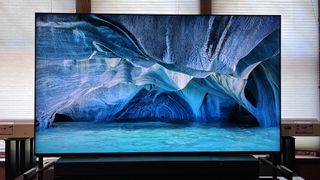
Sony Bravia 9 review: Picture quality
- Powerful brightness and contrast
- Refined local dimming
- Prime Video Calibrated picture mode
Sony is touting the Bravia 9 as its brightest TV yet, and my measurements bear that out. It measured 2,280 nits in Standard mode on a 10% white window test pattern with HDR, and 1,871 nits in Movie mode. Full-screen brightness is also excellent, with the Bravia 9 measuring 708 nits on a white 100% pattern in Standard mode and 495 nits in Movie mode. To put those numbers in context, the Samsung QN900D, that company’s more expensive flagship 8K TV, had a peak light output of 1,979 nits on a 10% window when I measured it and 528 nits on a fullscreen pattern.
The brightness of the best OLED TVs has come a long way over the past year or two, but they still lag behind the Bravia 9. Samsung’s flagship S95D OLED, for example, managed a peak light output in Standard mode of 1,868 nits when we tested it and 327 nits on a fullscreen pattern. Those are excellent numbers for any TV, and having seen the the S95D in person, I can confirm that it is a fantastic-looking set – just one not as bright as the Bravia 9.
Coverage of the UHDA-P3 color gamut – the one used for mastering 4K HDR movies for disc and streaming – on the Bravia 9 was 95.8%, while BT.2020 coverage was 77.6%. Those results are roughly equivalent to what I measured on the Samsung QN900D, while the Samsung S95D beat both with full P3 coverage and 87.9% BT.2020 coverage. Grayscale and color point accuracy in Movie mode averaged out to 4.7 and 3.6, respectively. Those results are both above the accuracy threshold we expect high-end TVs to clock in under, though Sony’s 20-point white balance and color adjustments enabled me to dial averages back to 1.3 for grayscale and 2.6 for color – so while it was a tiny beat weak out of the box, it was excellent with a bit of tinkering.
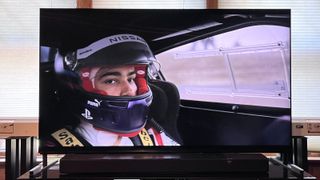
Okay, enough numbers – how did movies and TV shows look on the Bravia 9? Watching Ripley on Netflix, the TV’s high peak brightness let the play of light on water take on an extra level of sheen, while clouds in the black and white images showed a strikingly rich range of gray tones. Blacks also looked deep and shadowy images had plenty of above-black detail.
The Trinity test in Oppenheimer is a good sequence for testing black depth and local dimming performance, and I was highly impressed by the Bravia 9’s performance here. Lamps surrounding the compound in the nighttime shots cut through the blackness powerfully with no discernable blooming effects. When the bomb is eventually detonated, the resulting massive plume of flames looked vivid and bright and carried a rich palette of orange and red hues.
Checking out the Spears & Munsil Ultra HD Benchmark 4K Blu-ray for further confirmation of the Bravia 9’s local dimming prowess, I watched the part of the demonstration material section that showcases high-contrast images. White highlights in a shot of a Ferris wheel at night looked detailed with no light bleed into the black background. That’s something I typically see on OLED TVs, but mini-LED sets almost always show some degree of light bleed – until now. An aerial shot of a city at night also displayed powerful contrast between deep shadows and bright highlights, and the fine gradation of in-between tones fleshed out architectural detail in the buildings.
The Sony Bravia 9 has a new Prime Video Calibrated picture mode that automatically kicks in when you stream video from Amazon’s service and can be switched off in the TV’s menus. I got mixed results when comparing this to my own calibration of the TV’s Movie mode. Scenes from The Lord of the Rings: The Rings of Power looked warmer and darker with Prime Video Calibrated mode active, while a live Yankees vs. Kansas City Royals baseball game came off as cooler and brighter (but generally fantastic in either mode – the Bravia 9, with its high brightness and anti-reflection screen, is a great TV for watching sports). Fortunately, it’s easy to toggle the mode on and off via a small menu at the corner of the screen that lets you see the full picture in the background.
- Picture quality score: 5/5
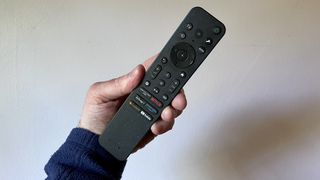
Sony Bravia 9 review: Sound quality
- 2.2.2-channel Dolby Atmos speaker system
- Enhanced features with Sony soundbars and speakers
- Impressive overall sound
Sony calls the Bravia 9’s built-in 2.2.2-channel, 70-watt audio system «Acoustic Multi-Audio+,» and in this case, that means the TV has “Frame” tweeters positioned in the left and right sides of its frame, and “Beam” tweeters located at the top. There is also 3D Surround Upscaling for non-Atmos or DTS:X soundtracks and a feature called Voice Zoom 3 that uses AI to recognize and isolate dialogue so it can be boosted separately from the rest of the soundtrack for enhanced voice clarity.
Other audio features can be unlocked when the Bravia 9 is paired with a Sony soundbar or speaker system. Acoustic Center Sync lets you connect a soundbar or speakers to the TV so the TV can be used as the center channel speaker in the system. And 360 Spatial Sound Mapping creates “phantom” speakers between the physical ones for enhanced immersion. Voice Zoom 3 can also be used when the TV is connected to an external audio system, with the built-in speakers tasked with carrying – and boosting – the dialogue level.
The sound quality of the Bravia 9’s built-in speakers was well above average. When I watched a scene from Top Gun: Maverick where Maverick first addresses his class of pilots as the team leader, the dialogue was clear and full-bodied and it seemed to be coming directly from the mouths of characters on-screen. Acoustic Multi-Audio+ also created a good sense of spaciousness, with sound effects extending well off from the top and sides of the TV itself.
Few TVs are capable of deep bass, and the same applies to the Bravia 9. Fortunately, Sony also sent me its Bravia Home Theater Quad wireless speaker system ($2,499) and SA-SW5 wireless subwoofer ($699) to test with the Bravia 9. With the Theater Quad’s wireless control box plugged into the TV so the Bravia 9 could be used as the 4.1.4 system’s center channel speaker (thus making it a 5.1.4-channel system), there was bass a-plenty and Dolby Atmos effects were powerfully conveyed. More to the point for this review, the Bravia 9 integrated perfectly with the external audio system, delivering smooth and seamless sound.
- Sound quality score: 4.5/5
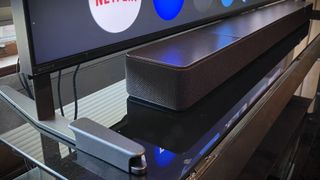
Sony Bravia 9 review: Design
- Aluminum pedestal stand
- Magic Remote with point-and-click capability
- Hands-free voice control option
The Bravia 9’s “One Slate” design gives it a monolithic look, with the TV’s dark aluminum frame blending in cleanly with any surface it’s set upon. Sony’s four-way support feet can be used for a range of installation configurations, including both flat and elevated heights, and narrow or wide positions to accommodate a soundbar. Removable covers are provided to conceal wires on the TV for a clutter-free look, further enhancing the One Slate design concept.
Connections on the Bravia 9 include four HDMI ports (two of which are HDMI 2.1), optical digital audio out, and an RF antenna port for the TV’s ATSC 3.0 digital TV tuner. There are also two USB type-A and RS-232 and IR control ports.
Sony says the Bravia 9’s rechargeable Eco Remote is made from 79.7% recycled plastic. It has a slim design, premium feel, and backlit keypad, and is charged using an included USB-C cable.
- Design score: 5/5
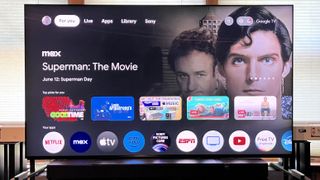
Sony Bravia 9 TV review: Smart TV and menus
- Google TV with hands-free voice assistant
- AirPlay 2 and Chromecast built-in support
- Wide array of picture and audio settings
Google TV is Sony’s smart TV platform of choice, and is a good one by any measure. Any streaming app you could ask for is available, along with the ability to customize the placement of apps in the main “For You” home screen. When you’re signed in with a Google account, the For You view will show content recommendations based on your viewing and Google search history, and you can use Google Assistant for hands-free voice commands by turning on the built-in mic via a control switch located alongside the TV’s inputs.
Other smart TV features include a Live TV grid that shows free steaming channels and broadcast TV ones pulled in from an antenna by the TV’s built-in ATSC 3.0 tuner (US-only). Both AirPlay 2 and Chromecast built-in are supported, and the TV also works with Amazon Alexa devices and supports Apple Homekit. A new Sony TV feature for 2024 is the Eco Dashboard, which gives a comprehensive overview of the TV’s power savings settings and can display a detailed graph showing your power consumption over time in kilowatt-hours (kWh).
A fairly huge number of picture and audio settings are available on the Sony Bravia 9, some of which can be quickly accessed on a quick screen by pressing the wrench icon button on the remote control. The Settings option takes you to a more detailed menu for configuring picture, audio, smart TV, and system settings. The picture menu provides a wide range of options for adjusting contrast, black levels, and HDR handling, including Gradation and Brightness Preferred options for HDR tone mapping.
I found it necessary to visit the Motionflow settings in the Motion menu when watching movies in Dolby Vision, which by default get motion smoothing in the TV’s Dolby Vision Bright and Dark modes. (Future models will hopefully feature the Dolby Vision Filmmaker mode featured in the LG C4 OLED.)
- Smart TV & menus score: 4.5/5
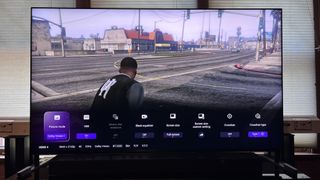
Sony Bravia 9 review: Gaming
- 2x HDMI ports with 4K 120Hz, VRR, and ALLM
- Auto HDR tone mapping and game genre picture modes
- 17ms input lag is higher than other premium TVs
The Sony Bravia 9 has good suite of gaming features, including support for 4K 120Hz, VRR, and ALLM. That support is only available on two of its four HDMI ports, however, which makes it difficult for gamers with both Xbox Series X and PlayStation 5 consoles to get the highest quality gaming experience when a soundbar is also connected to the TV – though at least with this TV, you might not need a soundbar.
Like other Sony TVs with a 120Hz refresh rate, the Bravia 9 is Perfect for PlayStation 5, with Auto HDR Tone Mapping and Auto Genre Picture Mode features kicking in when a PS5 console is detected. It also has Sony’s Game Menu, which lets you easily adjust gaming-related settings such as picture mode, black equalizer, and picture size, as well as select crosshair type. The Bravia 9 also supports 4K Dolby Vision gaming.
I measured input lag on the Bravia 9 at 17ms using a Leo Bodnar 4K meter. That level should be fine for most console gaming, but other premium TVs we’ve recently tested measured under 10ms on the same test.
- Gaming score: 4/5
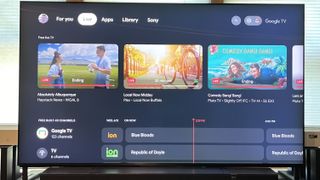
Sony Bravia 9 review: Value
- Picture quality helps justify the price
- Costs less than other premium TV options
- Not the greatest choice for gamers
At $2,999 for the 65-inch version I tested (and with the 75-inch model that’s available globally costing $3,499 / £4,499 / AU$6,995) the Sony Bravia 9 is undoubtedly a pricey TV option. But the 8K Samsung QN900D mini-LED and Samsung S95D OLED, perhaps its closest TV rivals when it comes to performance, are priced at $4,999 and $3,399, respectively, making the Bravia 9 something of a high-end TV bargain.
Samsung’s flagship 8K TV offers excellent picture detail, along with high brightness and refined local dimming. Its flagship OLED offers an equally compelling and nearly as bright picture, plus a highly effective anti-glare screen coating for daytime viewing. Both those TVs are also better options for serious gaming than the Bravia 9.
Does the Bravia 9’s compellingly bright, refined picture justify its price tag? As I said, when considered in a high-end TV context, Sony’s flagship TV is something of a bargain. You could spend less on a mid-range OLED or a cheaper mini-LED TV with the same screen size, but if you happen to see the Bravia 9 in action, you may not be as happy with those alternatives.
- Value score: 4/5
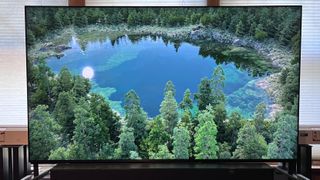
Should I buy the Sony Bravia 9 TV?
Swipe to scroll horizontally
| Attributes | Notes | Rating |
|---|---|---|
| Features | An excellent array of features to enhance picture and audio quality | 4.5/5 |
| Picture quality | Fantastic picture quality with high overall brightness and refined local dimming | 5/5 |
| Sound quality | Very good overall sound quality with Dolby Atmos and DTS:X support; can be used as a center channel speaker in an extended audio system | 4.5/5 |
| Design | Sleek, yet substantial build quality with four-way support feet to accommodate various installations | 5/5 |
| Smart TV and menus | Google TV is a solid streaming option and here it has a built-in mic for hands-free voice commands | 4.5/5 |
| Gaming | A good set of gaming features, but only two HDMI 2.1 ports | 4/5 |
| Value | Pricey when considered in a wider TV context, but a great value next to its flagship competition | 4/5 |
Buy it if…
You want a great TV for movies
The Bravia 9’s high peak brightness and refined local dimming make it an excellent option for viewing 4K movies with HDR.
You want a great TV for sports
Sports look fantastic on the Bravia 9 which has a very bright overall picture, along with an anti-reflection screen for daytime viewing.
